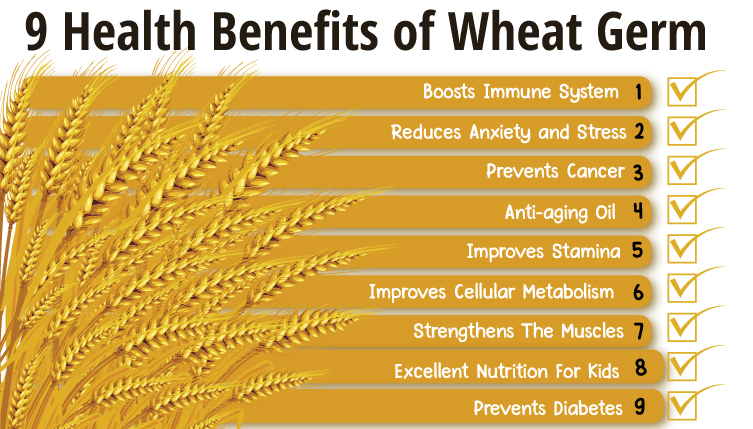Nutrition Value Of Wheat Germ
Here is a list of nutrition values that you can find in every two teaspoons of wheat germ. Add this wheat germ nutrition value to your diet to enhance your daily meals.
- 1 gram of unsaturated fat,
- 2 grams of dietary fibre,
- 10% of the daily folate intake,
- 8% of daily phosphorus, magnesium, and zinc intakes,
- 15% of daily vitamin E needs, and
- 10% of daily thiamin needs
9 Health Benefits of Wheat Germ
We already know that a wheat germ is an incredible storehouse of healthy nutrients. Let’s now look at some of the fantastic healthy wheat germ benefit

Do you have frequent, continuous sickness? Your immunity will quickly improve if you include wheat grams in your diet. Since free radicals and other disease-causing germs are stimulated by the high levels of antioxidants found naturally in wheat germ, the likelihood of developing severe sickness is decreased or eliminated.
2. Reduces Anxiety and Stress
Feel low and anxious too often? How about trying wheat germ for a change?
It’s an excellent source of omega-3 fatty acids the attitude to ALL your mood swings and nervousness. Eating wheat germ regularly lowers anxiety levels and improves mood.
This has to be the wheat germ most significant health benefit. Vitamin A and D-rich wheat germ can be used to treat colon and skin cancer. Studies claim that consuming a specific fermented wheat germ extract (Avemar) once or twice daily for at least six months while receiving chemotherapy helps lower mortality risk and prevents cancer from worsening or spreading.
4. Benefits of Wheat Germ Oil for Anti-aging
Wheat germ significantly impacts anti-ageing aspects like hair loss and skin health because it is rich in vitamins and nutrients. Wheat Germ Oil extracts soften and promote skin flexibility while protecting and hydrating the skin. The Oil's anti-aging characteristics enable the skin to prevent wrinkles. and soothe dry skin.
When applied regularly, the oil’s proteins and vitamins can help patients with psoriasis, sunburn, dermatitis, wrinkles, a dull complexion, and receding hairlines.
5. Improves Stamina
Although there is still much to learn about this subject, several studies have suggested that wheat germs are a natural energy and performance enhancer. They contain a lot of octacosanols, which boost stamina and performance. Health experts do not entirely back this assertion in light of limited scientific evidence. Nevertheless, octacosanol is employed in managing several conditions, including high cholesterol, ALS, Parkinson's disease, and Lou Gehrig's disease.
6. Improves Cellular Metabolism
Wheat germs are also a good source of Vitamin-B group nutrients. Niacin, thiamine, and folates are the most prevalent kinds found in wheat germ. These vitamins are essential for cellular metabolism because they aid in converting nutrients like glucose, lipids, and dietary lipids into cellular energy that cells can use. Additionally, thiamine can combat metabolic diseases, including persistent obesity.
7. Strengthens The Muscles
Wheat germ is one of the best protein sources, and protein has a long list of health benefits. The body needs protein to maintain healthy muscles, repair injured tissues, control energy levels, maintain homeostasis, and maintain overall system balance. People who want to lose weight and build more muscle should add wheat germs as part of their diet plan.
8. Excellent Wheat Nutrition For Kids
Given its nutrient-dense makeup, wheat germ is a fantastic food option for infants and young children. And they go perfectly well with yoghurt, fruit, and vegetable purees. So there's nothing complicated about its preparation.
Furthermore, wheat germ has a lot of folic acids, which is crucial for pregnant women to have a healthy baby. Neural tube abnormalities and other issues are considerably less likely in children born to mothers with adequate folate levels in their bodies.
9. Prevents Diabetes
Wheat germ has a lot of dietary fibre. Fibre is your friend if you have diabetes or prediabetes since it aids in controlling your weight and blood sugar levels.
Additionally, the amino acid "homocysteine" is known to raise blood sugar levels. Folic acid is present in very high concentrations in wheat germ. So folic acids from wheat germs also help break down homocysteine" into other compounds that your body needs. Lower homocysteine level in the bloodstream reduces your risk of cardiovascular diseases and diabetes.
Wheat Germs Use in Daily Life
There is no specific daily guideline for wheat germ. To avoid potential issues, you might need to start with a tiny portion, like one tablespoon daily. As your body adjusts, you can progressively increase your consumption. There are numerous methods to include it in your diet, and you can also eat it raw.
Adding raw wheat germ to hot or cold cereal or yoghurt is a typical way to consume it. For kids and children, you can add them to muffins, casseroles, or pancakes during preparation as well. If you love smoothies, there is no harm in adding a teaspoon of Wheat germ to them. It will be the perfect combo of taste and healthfulness.
Although wheat germ possesses anti-inflammatory and antioxidant qualities, its high fibre content leads to digestive problems like bloating and diarrhea after excessive consumption and stomach cramps.
Some people may have minor adverse effects from wheat germ extract. These include gas, bloating, diarrhea, and dizziness.
Is Wheat Germ Gluten Free?
Wheat germ is not gluten-free as it originates from the core of whole wheat. As we all know, wheat is a good source of gluten and fiber. Therefore wheat germ contains sufficient gluten that can affect the Health of gluten-sensitive people. Moreover if you’re gluten intolerant and want to add a rich fibrous diet in your meal then you must avoid Wheat germ. Instead you can add some Fibre-rich fruits and vegetables like sweet potato in your diet.
Wheat germ benefits for skin
1. Moisturizing: Wheat germ oil is rich in vitamin E and fatty acids. It can help hydrate and nourish the skin, leaving it feeling soft and smooth.
2. Antioxidant Potential: The vitamin E content might have antioxidant properties. It potentially helps protect the skin from free radical damage, a contributor to premature ageing.
3. Soothing: Some studies suggest wheat germ oil may have anti-inflammatory properties that potentially reduce redness and irritation.
4. Cell Regeneration: Vitamins B and E might promote healthy skin cell regeneration and aiding in wound healing. Potentially it improves overall skin health.
Conclusion
By now, we are sure you are well aware of the various health benefits of wheat germ. However, please keep in mind that the effect of wheat germs on our overall health is still a topic of research. So, consult your dietician and doctor once before using wheat germ for any of the health benefits listed in this article. Additionally, a person who is suffering from obesity can find out the wheat germ benefits for weight loss. Users can connect us for more guided information regarding wheat germ and its perks. On our platform, we have hundreds of highly rated dieticians. Book an appointment online now.
1. Should you eat wheat germ if you are gluten intolerant?
For those who are gluten intolerant, wheat germ is an absolute no-no. Wheat germ supplements should not be taken as supplements or raw by anyone with a gluten allergy as they contain gluten.
2. Should people on low-carb diets eat wheat germ?
Yes! Wheat germs are permitted on low-carb diets, but only in moderation. Remember that one cup of white germs has over 60 grams of carbohydrates. So plan your intake accordingly.
3. Can you overeat wheat germ?
Because of the increased fibre in your diet, large quantities of wheat germ are likely to irritate your digestive system. So overeating is ideally not advised. As far as possible, stick to a moderate portion and keep track of your daily fibre intake.
4. Is wheat germ good for high cholesterol?
Phytosterols, which are compounds that aid in reducing cholesterol absorption, are present in wheat germ. They can prevent your intestines from absorbing harmful cholesterol and reduce the risk of heart attack and cardiovascular disease.
5. How to make fermented wheat germ extract?
Homemade fermented wheat germ extract isn't recommended due to potential contamination risks. You can create a fermented wheat germ product by combining wheat germ with water and a starter culture (like yoghurt or kefir). Afterwards, let it get back to room temperature for a day. You will notice that the fermented stem of wheat germ pops out. However, commercially produced extracts likely undergo a more controlled fermentation process for safety and potency.



 Contact Us
Contact Us







 Hospitals
Hospitals
 Doctors
Doctors
 Diagnostic
Diagnostic
 Pharmacy
Pharmacy
 Health Tips
Health Tips
 Blog
Blog


















Comments